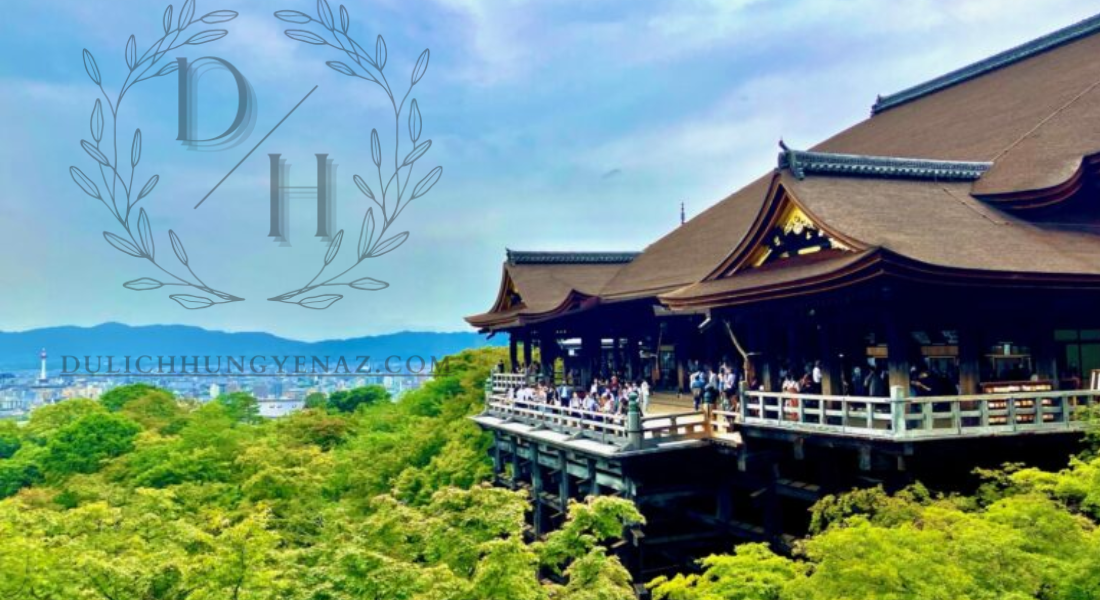Kyoto, the cultural heart of Japan, is renowned for its breathtaking temples, tranquil shrines, and serene gardens that offer a window into Japan’s spiritual and historical heritage. As the former capital of Japan, Kyoto is home to thousands of ancient temples and shrines, each reflecting the country’s profound traditions and unique architectural styles. For travelers seeking a peaceful and meaningful experience, Kyoto’s temples and shrines provide an immersive escape into a world of quiet beauty and spiritual reflection.
Key Highlights
- Why Kyoto is Known for Temples and Shrines: The cultural and historical significance of Kyoto’s sacred sites.
- Top Temples and Shrines for Peaceful Visits: Must-see spots for a serene experience.
- How to Experience Kyoto’s Spiritual Side Like a Local: Tips for respectful and meaningful visits.
- Best Times to Visit Kyoto’s Temples and Shrines: Seasons and times to enjoy the best views and avoid crowds.
1. Why Kyoto is Known for Temples and Shrines: A Center of Japanese Spiritual Heritage
Kyoto, as the historical capital of Japan, has long been a hub of culture, religion, and politics. Many of Japan’s most famous Buddhist temples and Shinto shrines were built here, dating back to the Heian Period (794–1185) and beyond. These sacred sites offer a glimpse into Japan’s history, featuring beautiful architecture, ancient rituals, and peaceful landscapes. Kyoto’s temples and shrines not only represent spiritual devotion but also showcase stunning craftsmanship, from intricate wooden structures to serene gardens and sacred spaces.
Significance of Kyoto’s Temples and Shrines:
- Spiritual and Historical Importance: Each temple and shrine reflects unique religious traditions and the profound spirituality of Japanese culture.
- Architectural Beauty: Temples and shrines in Kyoto are renowned for their intricate woodwork, golden details, and harmonious design with nature.
- Peaceful Atmosphere: Many of these sites are surrounded by tranquil gardens, making them ideal for meditation and relaxation.
2. Top Temples and Shrines for Peaceful Visits
Kyoto is home to thousands of temples and shrines, but some stand out for their beauty, historical significance, and serene ambiance. Here are the top temples and shrines for a peaceful visit.
A. Kinkaku-ji (The Golden Pavilion)
Overview: One of Japan’s most iconic sites, Kinkaku-ji, or the Golden Pavilion, is a Zen Buddhist temple adorned with gold leaf. Set against a peaceful pond, Kinkaku-ji’s stunning reflection on the water is a sight to behold.
Highlights:
- Golden structure that glows beautifully under sunlight.
- Tranquil garden paths and a picturesque pond.
- Seasonal beauty, with cherry blossoms in spring and vibrant leaves in autumn.
B. Fushimi Inari-taisha Shrine
Overview: Fushimi Inari-taisha is one of Kyoto’s most famous Shinto shrines, known for its thousands of vibrant red torii gates that lead up the mountain. This shrine is dedicated to Inari, the Shinto god of rice and prosperity.
Highlights:
- Iconic red torii gate pathways that create a magical atmosphere.
- Small shrines and statues of foxes, which are sacred animals in Shinto.
- Hiking trails that offer scenic views of Kyoto as you reach the higher points of the mountain.
C. Kiyomizu-dera Temple
Overview: Located on the hillside, Kiyomizu-dera is a large wooden temple known for its spacious balcony offering panoramic views of Kyoto. It is especially popular during the cherry blossom and autumn foliage seasons.
Highlights:
- Scenic views of Kyoto from the temple’s wooden terrace.
- Waterfall where visitors can drink for good fortune.
- Historical streets around the temple lined with shops and tea houses.
D. Ryoan-ji Temple
Overview: Ryoan-ji is a Zen Buddhist temple famous for its minimalist rock garden, a symbol of Zen aesthetics and contemplation. The temple’s garden features a simple design of rocks and raked gravel, meant to inspire meditation and reflection.
Highlights:
- Iconic rock garden, one of the most famous examples of Zen landscape design.
- Serene pond and seasonal blossoms in the surrounding garden.
- Peaceful atmosphere ideal for quiet meditation and contemplation.
E. Ginkaku-ji (The Silver Pavilion)
Overview: Known as the Silver Pavilion, Ginkaku-ji is a Zen temple surrounded by meticulously designed gardens. Although the pavilion is not covered in silver, it reflects a quieter beauty, symbolizing the Zen spirit of simplicity.
Highlights:
- Elegant gardens with sand sculptures and moss-covered paths.
- Tranquil pond and hillside views.
- Minimalist design that emphasizes harmony and balance.
3. How to Experience Kyoto’s Spiritual Side Like a Local
Exploring Kyoto’s temples and shrines like a local allows for a more respectful and fulfilling experience. Here are some ways to connect with Kyoto’s spiritual heritage on a deeper level.
A. Practice Quiet Reflection and Respect
Japanese temples and shrines are sacred places where silence and respect are highly valued. Avoid loud conversations, and take time to sit in quiet reflection, appreciating the tranquil atmosphere of each location.
B. Purify Yourself at the Chōzuya
Most shrines have a chōzuya, or purification fountain, where visitors cleanse their hands and mouth before approaching the main shrine. Use the ladle to rinse your left hand, then your right hand, and finally, rinse your mouth for a symbolic cleansing.
C. Bow and Clap at Shrines
At Shinto shrines, it’s customary to bow twice, clap twice, and bow once more after making a wish. This ritual shows respect to the kami (deities) of the shrine and allows you to connect with the spiritual atmosphere.
D. Observe Seasonal Changes
Kyoto’s temples and shrines are beautiful year-round, but they offer unique charms in each season. Cherry blossoms in spring, lush greenery in summer, autumn foliage, and snow-covered landscapes in winter create different moods, so visiting during various seasons provides a richer experience.
4. Best Times to Visit Kyoto’s Temples and Shrines
While Kyoto’s temples and shrines are open year-round, certain times and seasons can enhance your experience by avoiding crowds and enjoying seasonal beauty.
A. Early Morning for Peaceful Visits
For a quiet experience with fewer visitors, consider arriving early in the morning, as many temples open around 8 a.m. Early mornings provide a calm atmosphere and allow for uninterrupted views.
B. Cherry Blossom Season (March–April)
Spring brings cherry blossoms, or sakura, transforming Kyoto’s temples and shrines into stunning pink landscapes. However, this is a popular time, so early visits are recommended to avoid large crowds.
C. Autumn Foliage (November)
Kyoto’s autumn foliage season is a breathtaking time to visit, as maple trees around temples turn vibrant shades of red and orange. Many temples illuminate their gardens at night, creating a magical setting for evening visits.
D. Winter for a Tranquil Atmosphere
Winter is an ideal season for those seeking a peaceful experience, as Kyoto’s temples are less crowded. Snow-covered landscapes around temples create a serene, almost mystical ambiance.
Conclusion
Kyoto’s temples and shrines offer a captivating glimpse into Japan’s rich cultural and spiritual heritage. From the golden glow of Kinkaku-ji to the tranquil pathways of Fushimi Inari-taisha, these sacred sites provide a serene escape and a unique opportunity to connect with Japan’s timeless traditions. Whether you’re seeking quiet reflection, stunning architecture, or a journey through Japanese spirituality, Kyoto’s temples and shrines deliver an unforgettable experience that leaves a lasting impression.
FAQ
- What is the best time to visit Kyoto’s temples and shrines?
Early mornings and weekdays are best for avoiding crowds. Cherry blossom season (March-April) and autumn foliage (November) are also beautiful times to visit. - Do I need to pay an entrance fee at Kyoto’s temples and shrines?
Some temples charge a small fee (around ¥300–¥500) for maintenance, while most shrines are free to enter. - What should I wear when visiting temples and shrines in Kyoto?
Dress modestly and avoid clothing that is overly revealing, as these are sacred spaces. - How should I behave at temples and shrines?
Maintain a respectful and quiet demeanor, and follow any rituals you observe, such as cleansing at the chōzuya or bowing at Shinto shrines. - Can I take photos at Kyoto’s temples and shrines?
Photography is allowed at most temples and shrines, but always check for signs or ask if unsure, as some areas are off-limits for photography.






